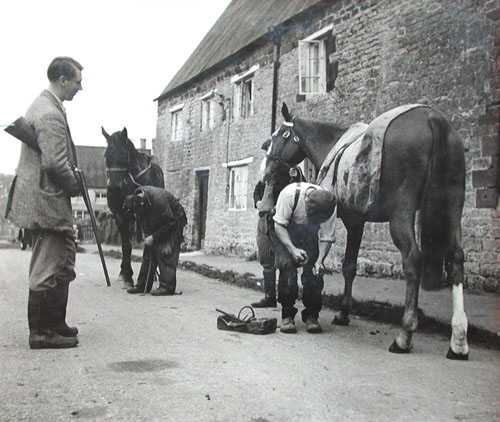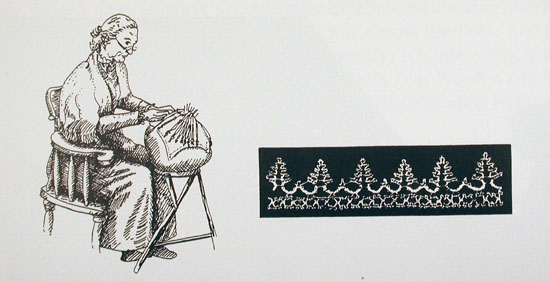
The last known Blacksmith in Sulgrave, George Gascoigne,
shoeing a horse outside his smithy in Church Street.
SULGRAVE TRADE AND INDUSTRY
(Back to Chapter 1 Index)
Sulgrave has nearly a thousand years of recorded history. For most of that time, it must have been very like many other inland villages, with agriculture as its principal industry, developing through various stages, and with other activities either very closely associated with that industry or being services essential to support its daily life. Indeed, given Sulgrave's comparative isolation and distance from any large town and also its dearth of communications, it was almost inevitable that it should be a fairly self-sufficient village, until relatively recently. It is interesting to note that, even as recently as 100 years ago, Sulgrave, Culworth, Lois Weedon and Wappenham were described as "the lost villages" on account of their location well away from major roads and centres.
The first detailed records giving particulars of Sulgrave's inhabitants are the Militia Lists of the 18th century. Those of the 1760s and 1770s reveal many of the expected occupations of a village - farmer, freeholder, husbandman, labourer, servant - and a range of trades, which were, in effect, local service activities in support of the village's one industry and of its normal, everyday life - baker, butcher, carrier, chandler, gorcer, maltster, shoemaker, shopkeeper, tailor, blacksmith, carpenter, joiner, mason, wheelwright, weaver, woolcomber. Interestingly, weaver and woolcomber had disappeared from the Lists by 1777, wich is perhaps a reflection of changes in the nature of local agriculture. It is also worth noting that, from one List to another, the numbers, inevitably small and, in many cases, only one in total, varied. One wonders, for example, why there were no shoemakers listed in 1771, but four of them in 1777.
The answer may lie in the nature of those liable for service in the Militia, at least in part. The Militia Lists do not necessarily provide a comprehensive picture of village occupations and trades. They cover only able-bodied males between the ages of 18 and 45 years, excluding, for example, titled individuals, clergy and, seemingly, poor men with three or more children. This may explain the absence of any mention of millers from the Sulgrave Lists, although there were, in all likelihood, two in the parish, given that there is strong evidence of both mills being in existence in the first half of the 16th century and that the windmill ceased operation only in 1915 and the watermill became disused probably just a little later.
Commercial directories are another source of information on the occupations and trades of Sulgrave of yore. Entries in one of 1849 show that Sulgrave boasted two millers in that year, one of them also being described as a farmer. Indeed, that same directory - so do most of the subsequent ones through to the early years of the 20th century - reveal that a number of people pursue more than one activity. The landlord of the Six Bells was rope-maker and a victualler, while his counterpart at the Three Compasses was a butcher and a victualler. The remainder of the entries cover one or two persons in each of the following occupations and trades - baker, butcher, builder, carpenter, clergy, school teacher, grocer, shoemaker, tailor, bonnet-maker, harness-maker, blacksmith, wheelwright. Farmers and graziers constituted, as is perhaps only to be expected, the largest category with a total of 11. Of particular interest, because it would not have been a standard village activity, is the mention of a rope-maker. This work was carried out where Spinners Cottages now stand. Bell ropes and other kinds of ropes were produced.

The last known Blacksmith in Sulgrave, George Gascoigne,
shoeing a horse outside his smithy in Church Street.
Subsequent directories in the 19th century and also ones published in the 20th century through to the Second World War have similar entries to the 1849 one, though inevitably some items, such as miller, disappear, and others are introduced. At the same time, the numbers in a particular category change, from time to time. Variations include a veterinary surgeon (1866), a lady rope-maker who was also a shopkeepeer and farmer (1869), an owner of steam thrashing (sic) machines (1869), a surveyor (1871), a gardener (1871), a lady connected with a day and boarding school (1874), a baker, coal merchant, sack contractor, farmer, grazier and land-owner (1879) (thus helping to perpetuate the tradition of jack-of-many-trades!), a coffee rooms owner (1885), a shopkeeper and post office (1894), a coach builder (1906), a cattle medicine vendor (1914), a motor cycle agent (1920), a cycle agent (1924), an antique dealer, a cattle cake agent and a newsagent (all in 1928), and a senior inurance agent and a bee farmer (both in 1936).
Not mentioned in any of the directories, is the lace-making of a Mrs Shellard (1843-1941), who, it is reported, also taught a number of mothers and children.

Within living memory, most of the traditional trades and occupations and the not-so-old ones mentioned above, which were carried on in the village, have disappeared. Agriculture, of course, remains Sulgrave's one industry. However, the number of working farms has decreased to five, with a corresponding decrease in the number of farmers and others employed. By contrast there were eleven farms in the parish in 1849, with an equal number of farmers and numerous workers employed on them. Village business activity is now confined to a shop, a public house, a guest house, an hotel, a small builder's yard, a livery stable, a motor garage, a security business and a computer consultancy. Obviously, in common with many other villages throughout the country, the nature of the employment of many of the inhabitants of Sulgrave has altered under the impact of greater educational opportunities, the attraction of what may be regarded as more sophisticated employment in surrounding towns, the higher degree of mobility afforded by modern transport, the much changed nature of farming and possibly other factors.
By far the greater number of residents in employment or business follow their occupations and professions outside the parish, in Banbury, Brackley, Daventry, Northampton and even as far afield as London. A recent survey showed that they worked in building and allied trades, catering, education, finance, industry of one kind or another, public service, retail trades and transport.
It is also notable that quite a significant number of residents have settled in Sulgrave purely for retirement purposes, having had no particular earlier connection with the village at all.